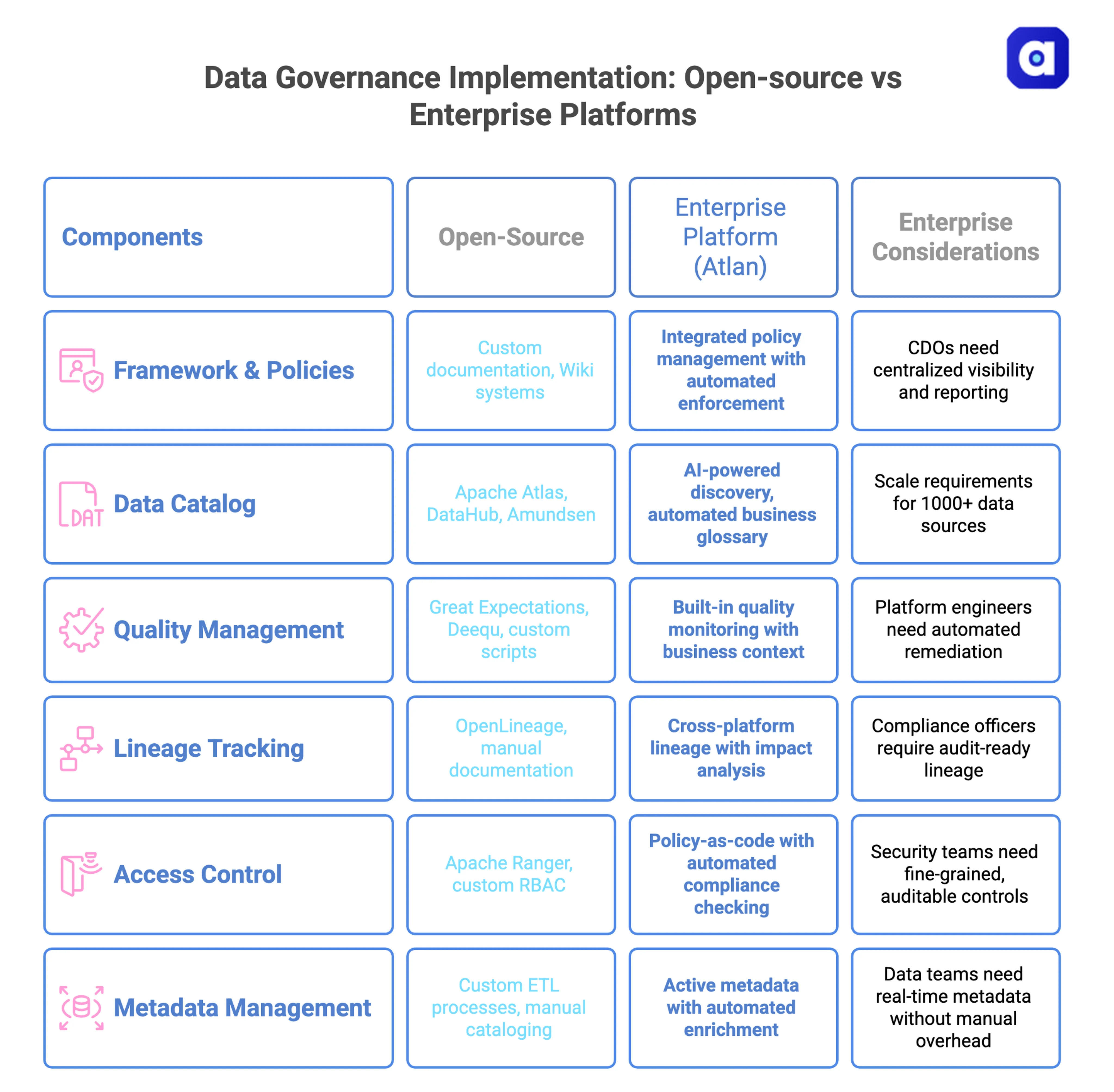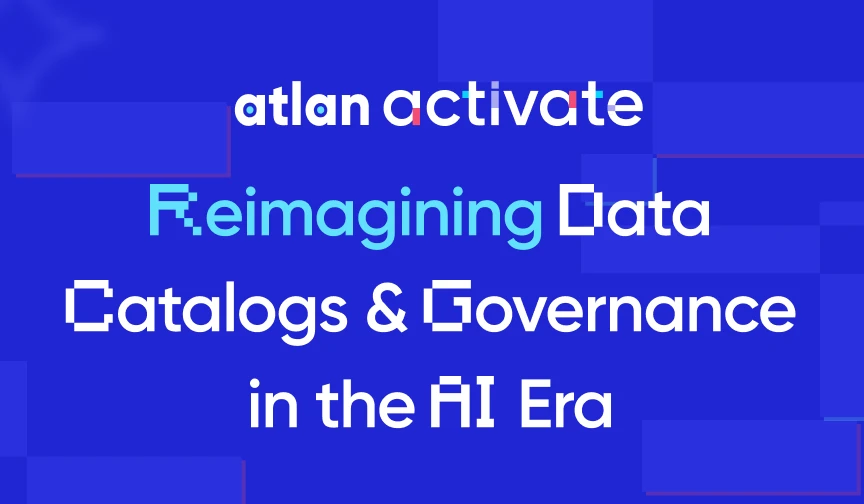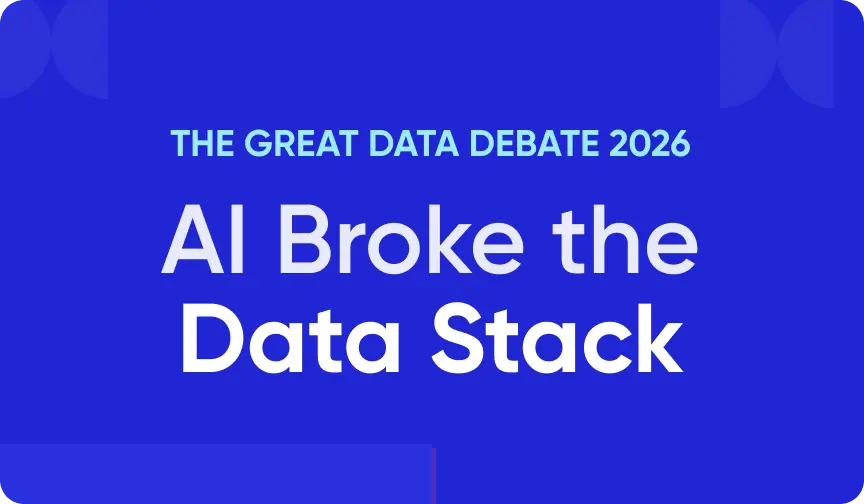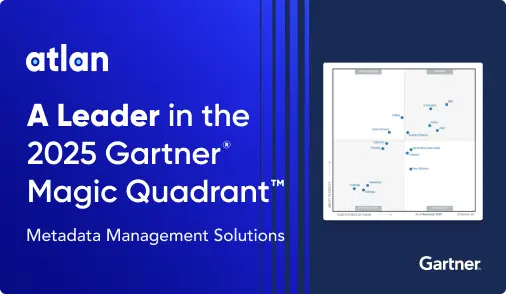Data Governance Key Components: 2026 Enterprise Implementation Guide
What are the ten key components of data governance?
Permalink to “What are the ten key components of data governance?”Summarize and analyze this article with 👉 🔮 Google AI Mode or 💬 ChatGPT or 🔍 Perplexity or 🤖 Claude or 🐦 Grok (X) .
Based on enterprise best practices, successful data governance programs require these foundational components working in concert:
| Component | Purpose | Key Elements | Success Metrics |
|---|---|---|---|
| 1. Data Governance Framework | Establishes strategic foundation with clear objectives, scope, and principles aligned to business goals and regulatory requirements | • Strategic objectives definition • Scope boundaries and coverage • Guiding principles and standards • Decision-making authority structure |
• Framework adoption rate across business units • Alignment score with business objectives • Regulatory compliance assessment score • Implementation priority: Foundation - Build First |
| 2. Roles and Responsibilities | Creates clear accountability structure through defined roles ensuring data ownership, stewardship, and consumption align with business outcomes | • Data Owners (business executives) - Strategic accountability • Data Stewards (business analysts) - Operational management • Data Custodians (platform engineers) - Technical implementation • Data Consumers (end users) - Usage compliance |
• Role fulfillment rate (% of data assets with assigned owners) • Accountability clarity score from stakeholder surveys • Issue resolution time by role responsibility • Implementation priority: Foundation - Build First |
| 3. Policies and Procedures | Provides documented guidelines for consistent data management covering classification, retention, privacy, security, and sharing protocols | • Data classification standards • Retention and archival schedules • Privacy protection measures • Security protocols and access controls • Data sharing agreements |
• Policy compliance rate across data assets • Policy violation incidents (target: <2% monthly) • Employee policy awareness score • Implementation priority: Core - Build Second |
| 4. Data Quality Management | Ensures data accuracy, completeness, and reliability through automated monitoring, validation, and improvement processes | • Quality metrics definition and monitoring • Automated validation rules • Data profiling and assessment • Cleansing workflows and remediation • Quality dashboards and reporting |
• Data quality score improvement (target: >95%) • Quality issue resolution time • Business user satisfaction with data accuracy • Implementation priority: Core - Build Second |
| 5. Data Catalog and Metadata Management | Creates centralized repository for data asset discovery, documentation, and relationship mapping enabling self-service analytics | • Business glossary and definitions • Technical metadata documentation • Data lineage tracking Impact analysis capabilities • Search and discovery interface |
• Catalog coverage (% of data assets documented • User adoption rate and search activity • Time-to-discovery for new data assets • Implementation priority: Core - Build Second |
| 6. Data Security and Privacy | Implements comprehensive protection measures ensuring data confidentiality, integrity, and regulatory compliance across all systems | • Access controls and authentication • Encryption standards (at-rest and in-transit) • Breach detection and response • Regulatory compliance monitoring (GDPR, HIPAA, SOX) • Privacy impact assessments |
• Security incident frequency (target: zero breaches) • Compliance audit scores • Access review completion rate • Implementation priority: Critical - Build Early |
| 7. Data Integration and Interoperability | Enables seamless data exchange across systems through standardized formats, processes, and common data models | • Standardized data formats and schemas • ETL/ELT process governance • API management and documentation • Common data models • Integration monitoring and validation |
• Integration success rate (% error-free data transfers) • Data synchronization latency • Cross-system data consistency scores • Implementation priority: Advanced - Build Third |
| 8. Data Stewardship and Change Management | Maintains ongoing governance through systematic updates, communication, and stakeholder engagement ensuring sustained adoption | • Schema change management processes • Data dictionary maintenance • Stakeholder communication protocols • Change impact assessment • Version control and documentation |
• Change implementation success rate • Stakeholder engagement levels • Governance process adherence • Implementation priority: Advanced - Build Third |
| 9. Training and Education | Builds organizational capability through comprehensive education programs ensuring widespread data literacy and governance adoption | • Role-based training curricula • Data literacy programs Governance workshops and certification • Best practices documentation • Ongoing education and updates |
• Training completion rates by role • Data literacy assessment scores • Post-training behavior change measurement • Implementation priority: Ongoing - Continuous Build |
| 10. Performance Measurement and Continuous Improvement | Tracks governance effectiveness through business-impact metrics enabling data-driven optimization and maturity advancement | • Business impact measurement • Compliance scoring and reporting • Governance maturity assessments • ROI calculation and tracking • Feedback loops and optimization |
• Governance maturity score improvement • Business value delivered (time-to-insight reduction) • ROI measurement and growth • Implementation priority: Ongoing - Continuous Build |
Why do these components matter for enterprise leaders in 2025?
Permalink to “Why do these components matter for enterprise leaders in 2025?”AI Initiative Success: Modern AI programs fail without proper data foundations. These components provide the trust, quality, and governance structure that AI systems require for reliable outcomes.
Risk Mitigation: With data breach costs averaging $4.45 million and regulatory fines reaching record levels, comprehensive governance isn’t optional—it’s essential business protection.
Operational Excellence: Organizations implementing these components report 30-50% reduction in data troubleshooting time and 25% faster time-to-insight for business decisions.
Competitive Advantage: Data-driven organizations with mature governance are 23 times more likely to acquire customers and 19 times more likely to be profitable.
How do I build each component systematically?
Permalink to “How do I build each component systematically?”Step 1: Establish your data governance framework
Permalink to “Step 1: Establish your data governance framework”For CDOs: Define strategic objectives aligned with business outcomes - data quality improvement, regulatory compliance, AI readiness. Establish scope covering all business units and data types, with guiding principles emphasizing accuracy, transparency, and accountability. Document decision-making authority and escalation paths.
Example Implementation: A financial institution’s framework might prioritize regulatory compliance (Basel III, GDPR), data quality for risk modeling, and transparency for audit requirements, with clear scope boundaries covering trading, retail banking, and compliance data.
Step 2: Define roles and responsibilities
Permalink to “Step 2: Define roles and responsibilities”For Governance Leads: Create accountability through specific role definitions:
- Data Owners (Business executives): Accountable for data accuracy, completeness, and business value
- Data Stewards (Business analysts): Manage day-to-day data quality and policy compliance
- Data Custodians (Platform engineers): Implement technical controls, storage, and access management
- Data Consumers (End users): Follow usage policies and report quality issues
Step 3: Develop comprehensive policies and procedures
Permalink to “Step 3: Develop comprehensive policies and procedures”For Compliance Officers: Document specific guidelines addressing data classification, retention schedules, privacy protection measures, security protocols, and data sharing agreements aligned with regulatory requirements.
Step 4: Implement data quality management
Permalink to “Step 4: Implement data quality management”For Platform Engineers: Establish automated quality monitoring through quality metrics definition, validation rules implementation, automated data profiling, cleansing workflows, and quality dashboards for business stakeholder visibility.
Step 5: Deploy performance measurement
Permalink to “Step 5: Deploy performance measurement”For All Teams: Create dashboards tracking governance effectiveness, conduct regular audits, and establish feedback loops for continuous improvement based on business outcomes like time-to-insight reduction and compliance scores.
How these data governance components work together
Permalink to “How these data governance components work together”The 10 components function as an integrated system rather than independent elements:
Foundation layer: Strategy and scope determine which data needs governance and why. The operating model assigns accountability. Policies and standards define the rules.
Execution layer: Technical components implement policies at scale:
- Quality management ensures data meets standards
- Metadata catalogs enable discovery and understanding
- Lineage tracks dependencies and impacts
- Security protects sensitive information
- Master data ensures cross-domain consistency
- Lifecycle management handles temporal aspects
Oversight layer: Risk and compliance provide audit support and regulatory alignment.
Enablement layer: Tooling automates execution. Measurement drives continuous improvement.
Organizations implement components iteratively. Start with high-value domains, prove governance value, then expand scope and sophistication over time.
Which enterprise frameworks align with these data governance elements?
Permalink to “Which enterprise frameworks align with these data governance elements?”DAMA-DMBOK framework integration:
Permalink to “DAMA-DMBOK framework integration:”- Components 1-3 (Framework, Roles, Policies) align with DAMA’s Data Governance and Data Architecture disciplines
- Components 4-5 (Quality, Catalog) correspond to Data Quality Management and Metadata Management functions
- Components 6-7 (Security, Integration) map to Data Security and Data Integration disciplines
ISO 8000 standards compliance:
Permalink to “ISO 8000 standards compliance:”- Provides international standards for data quality management that directly support Component 4
- Offers structured approaches for metadata management supporting Component 5
- Establishes quality measurement frameworks essential for Component 10
NIST privacy framework application:
Permalink to “NIST privacy framework application:”- Governs Component 6 implementation with structured privacy risk management
- Provides assessment methodologies supporting Component 10’s measurement requirements
- Offers incident response frameworks complementing data security policies
Modern data governance platforms like Atlan integrate these established frameworks into automated workflows, reducing manual implementation overhead while maintaining compliance with international standards.
Common pitfalls when rolling out data governance aspects
Permalink to “Common pitfalls when rolling out data governance aspects”Q: What’s the biggest mistake organizations make with governance roles?
Permalink to “Q: What’s the biggest mistake organizations make with governance roles?”A: Assigning accountability without authority. Data Owners need decision-making power, not just responsibility for outcomes they can’t control.
Q: Why do governance policies often fail to stick?
Permalink to “Q: Why do governance policies often fail to stick?”A: Policies created in isolation from daily workflows. Successful policies integrate seamlessly into existing business processes rather than creating additional bureaucracy.
Q: How do technical implementations go wrong?
Permalink to “Q: How do technical implementations go wrong?”A: Over-engineering solutions before understanding business requirements. Start with simple, automated approaches that deliver immediate value.
Q: What causes governance programs to lose momentum?
Permalink to “Q: What causes governance programs to lose momentum?”A: Lack of visible business impact measurement. Track metrics that matter to business stakeholders, not just IT operations.
How does AI governance extend governance components?
Permalink to “How does AI governance extend governance components?”AI governance builds upon traditional data governance components with additional considerations for algorithmic accountability:
- Bias Detection and Mitigation – Monitor model outputs for discriminatory patterns and implement fairness constraints across protected characteristics
- Model Drift Monitoring – Track performance degradation over time and establish automated retraining triggers when accuracy falls below thresholds
- Algorithmic Audit Trails – Document model decisions, training data lineage, and approval workflows for regulatory compliance and explainability
- NIST AI Risk Management Framework – Follow structured approaches for AI risk assessment and governance that complement existing data governance practices
Technology implementation: Open-source vs enterprise platforms
Permalink to “Technology implementation: Open-source vs enterprise platforms”
For enterprise implementations, the total cost of ownership often favors managed platforms due to reduced engineering overhead, automated compliance reporting, and integrated user experience across all governance components.
Real stories from real customers: Implement governance at scale
Permalink to “Real stories from real customers: Implement governance at scale”
Modernized data stack and launched new products faster while safeguarding sensitive data
“Austin Capital Bank has embraced Atlan as their Active Metadata Management solution to modernize their data stack and enhance data governance. Ian Bass, Head of Data & Analytics, highlighted, ‘We needed a tool for data governance… an interface built on top of Snowflake to easily see who has access to what.’ With Atlan, they launched new products with unprecedented speed while ensuring sensitive data is protected through advanced masking policies.”

Ian Bass, Head of Data & Analytics
Austin Capital Bank
🎧 Listen to podcast: Austin Capital Bank From Data Chaos to Data Confidence
Curious which components could unlock the same speed for your team?
Book a Personalized Demo →
53 % less engineering workload and 20 % higher data-user satisfaction
“Kiwi.com has transformed its data governance by consolidating thousands of data assets into 58 discoverable data products using Atlan. ‘Atlan reduced our central engineering workload by 53 % and improved data user satisfaction by 20 %,’ Kiwi.com shared. Atlan’s intuitive interface streamlines access to essential information like ownership, contracts, and data quality issues, driving efficient governance across teams.”
Data Team
Kiwi.com
🎧 Listen to podcast: How Kiwi.com Unified Its Stack with Atlan

One trusted home for every KPI and dashboard
“Contentsquare relies on Atlan to power its data governance and support Business Intelligence efforts. Otavio Leite Bastos, Global Data Governance Lead, explained, ‘Atlan is the home for every KPI and dashboard, making data simple and trustworthy.’ With Atlan’s integration with Monte Carlo, Contentsquare has improved data quality communication across stakeholders, ensuring effective governance across their entire data estate.”

Otavio Leite Bastos, Global Data Governance Lead
Contentsquare
🎧 Listen to podcast: Contentsquare’s Data Renaissance with Atlan
Ready to build all ten key components systematically
Permalink to “Ready to build all ten key components systematically”CDOs should prioritize framework establishment and role clarity first, followed by policy development and quality management based on highest business risk areas. The key to governance success lies not in perfect initial implementation, but in creating sustainable processes that evolve with organizational needs while maintaining compliance and data quality standards.
Implement your data governance with expert help
Book a Personalized Demo →FAQs about data governance key components
Permalink to “FAQs about data governance key components”1. What are the key components of data governance?
Permalink to “1. What are the key components of data governance?”Data governance consists of several key components, including a governance framework, defined roles and responsibilities, policies and procedures, data quality management, and data security measures. These components work together to ensure effective data management and compliance.
2. How does data governance impact data quality and compliance?
Permalink to “2. How does data governance impact data quality and compliance?”Data governance directly influences data quality by establishing standards and processes for data management. It ensures compliance with regulations by implementing policies that govern data usage, security, and privacy, thereby reducing risks associated with data breaches.
3. What roles and responsibilities are involved in data governance?
Permalink to “3. What roles and responsibilities are involved in data governance?”Key roles in data governance include Data Owners, Data Stewards, and Data Custodians. Each role has specific responsibilities, such as managing data quality, ensuring compliance, and overseeing data access and security.
4. What are the challenges of maintaining data governance in a decentralized environment?
Permalink to “4. What are the challenges of maintaining data governance in a decentralized environment?”Maintaining data governance in a decentralized environment can be challenging due to inconsistent data standards, lack of centralized oversight, and difficulties in ensuring compliance across different departments. Organizations must establish clear policies and communication channels to address these challenges.
5. How can data governance enhance data security and privacy?
Permalink to “5. How can data governance enhance data security and privacy?”Data governance enhances data security and privacy by implementing strict access controls, data classification, and compliance with regulations like GDPR. It ensures that sensitive data is protected and that organizations adhere to best practices for data management.
6. Does AI change which data governance components I need?
Permalink to “6. Does AI change which data governance components I need?”The core ten stay the same, but AI introduces new requirements inside each: policies must include bias thresholds, quality checks expand to drift detection, and lineage must trace back to training data. Successful AI programmes layer these “AI governance” controls onto the existing components rather than creating a separate framework.
Share this article
Atlan is the next-generation platform for data and AI governance. It is a control plane that stitches together a business's disparate data infrastructure, cataloging and enriching data with business context and security.
Data governance key components: Related reads
Permalink to “Data governance key components: Related reads”- Data Governance in Action: Community-Centered and Personalized
- The 3 Principles of Data Governance : Pillars of a Modern Data Culture
- Data Governance and Compliance: Act of Checks & Balances
- Key Objectives of Data Governance: How Should You Think About Them?
- Data Governance Framework — Examples, Templates, Standards, Best Practices & How to Create One?
- Data Governance Roles and Responsibilities : A Quick Round-Up
- Data Governance Policy: Examples, Templates & How to Write One
- Benefits of Data Governance: 4 Ways It Helps Build Great Data Teams
- 7 Best Practices for Data Governance to Follow in 2025
- How to implement data governance? Steps, Prerequisites, Essential Factors & Business Case
- Open Source Data Governance Tools - 7 Best to Consider in 2025
- Data Governance Tools: Importance, Key Capabilities, Trends, and Deployment Options
- Data Governance Tools Comparison: How to Select the Best
- Data Governance Tools Cost: What’s The Actual Price?
- Data Governance Process: Why Your Business Can’t Succeed Without It
- Data Governance and Compliance: Act of Checks & Balances
- Data Compliance Management: Concept, Components, Getting Started
- Data Governance for AI: Challenges & Best Practices
- A Guide to Gartner Data Governance Research: Market Guides, Hype Cycles, and Peer Reviews
- Gartner Data Governance Maturity Model: What It Is, How It Works
- Data Governance Maturity Model: A Roadmap to Optimizing Your Data Initiatives and Driving Business Value
- Data Governance vs Data Compliance: Nah, They Aren’t The Same!
- Data Governance in Banking: Benefits, Implementation, Challenges, and Best Practices
- Open Source Data Governance - 7 Best Tools to Consider in 2025
- Federated Data Governance: Principles, Benefits, Setup
- Data Governance Committee 101: When Do You Need One?
- Data Governance for Healthcare: Challenges, Benefits, Core Capabilities, and Implementation
- Data Governance in Hospitality: Challenges, Benefits, Core Capabilities, and Implementation
- 10 Steps to Achieve HIPAA Compliance With Data Governance
- Snowflake Data Governance — Features, Frameworks & Best practices























